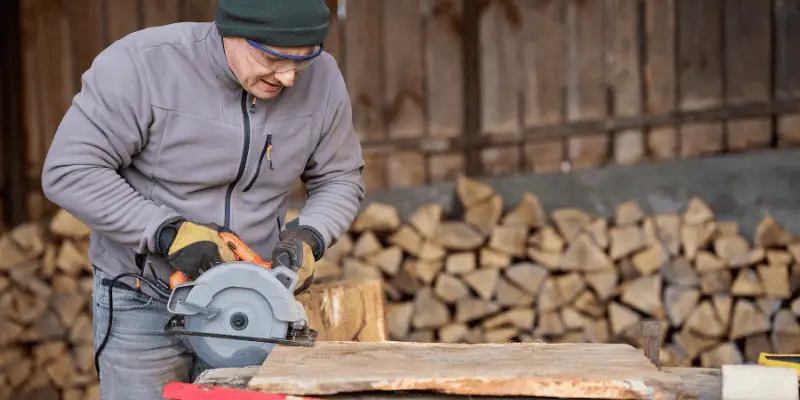When choosing between a track saw and a circular saw, consider the type of cuts you need to make and the level of precision required. Both tools have their own advantages and drawbacks, and your decision should be based on your specific needs.
Track saws are ideal for making long, straight cuts with precision and are often used for woodworking and cabinetry. On the other hand, circular saws are more versatile and can handle a wider range of cutting tasks, making them suitable for general construction and remodeling projects.
Understanding the differences between these two tools will help you choose the right one for your specific cutting needs.
Understanding The Functionality
When comparing track saws versus circular saws, it’s essential to understand the functionality of each tool. A track saw offers precision and straight cuts, ideal for woodworking, while a circular saw is versatile, suitable for cutting various materials. Consider the specific needs of your project when selecting the right tool.
When it comes to precise and efficient cutting in woodworking projects, both track saws and circular saws are popular choices. Each tool offers unique features and functionality, catering to different cutting needs. Understanding the functionality of these tools can help in making an informed decision for your specific woodworking tasks.
Track Saw: How It Works
A track saw is a portable and versatile cutting tool that operates on a guided track system. The track acts as a precise cutting guide, allowing the saw to make straight and accurate cuts. The saw’s blade is enclosed within a shroud, which enables it to cut within the track without any deviation. This design ensures that the cuts are clean, straight, and splinter-free.
Advantages For Precision Cutting
Track saws are ideal for precision woodworking due to their exceptional accuracy. The guided track system eliminates the need for additional measuring and marking, resulting in consistent and exact cuts. The ability to make straight, splinter-free cuts on various materials, including large panels and sheets, makes track saws a popular choice for professional woodworkers and DIY enthusiasts alike.
Limitations For Complex Cuts
While track saws excel in straight cuts, they may have limitations when it comes to intricate or complex cuts. Maneuvering the track saw around curved or irregular shapes can be challenging, as the guided track restricts freehand movements. Additionally, track saws may not be as efficient for bevel cuts or plunge cuts compared to circular saws.
Circular Saw: Precision Cutting Capabilities
Circular saws are known for their versatility and precision in various woodworking applications. These handheld power tools are capable of making precise straight cuts, bevel cuts, and plunge cuts in a wide range of materials. Their ability to handle complex cutting angles makes circular saws a valuable asset for projects that require flexibility and adaptability.
Ergonomics And Maneuverability
Circular saws are designed for maximum maneuverability, allowing users to navigate through intricate cuts with ease. The ergonomic handle and lightweight construction make circular saws suitable for extended use without causing fatigue. Their portability and maneuverability make circular saws a practical choice for both professional carpenters and DIY enthusiasts.
In conclusion, both track saws and circular saws have unique functionalities that cater to specific cutting requirements in woodworking projects. Understanding the strengths and limitations of each tool can help in selecting the most suitable option for achieving precision and efficiency in woodworking tasks.
Comparing Accuracy And Precision
When it comes to woodworking and precision cutting, choosing the right tool can make a significant difference in the outcome of your project. In this comparison of track saw vs circular saw, we’ll delve into the crucial aspects of accuracy and precision. Let’s explore the cutting performance and techniques for each tool to help you make an informed decision for your woodworking needs.
Track Saw: Precision Cutting Performance
The track saw is renowned for its exceptional precision cutting performance. Its ability to consistently deliver accurate cuts makes it a favorite among woodworkers and carpenters alike.
Cutting Straight Lines And Angles
The track saw excels in cutting straight lines and angles with unparalleled precision. The track guide system ensures that the saw remains on a specified path, eliminating the margin for error and providing precise cuts every time.
Accuracy With Guide Rails
The track saw’s compatibility with guide rails further enhances its accuracy. This feature facilitates seamless cutting along the predetermined path, resulting in flawless, precisely measured cuts.
Circular Saw: Limitations In Precision Cutting
While the circular saw is a versatile tool, it has inherent limitations in precision cutting. Its freehand operation may lead to slight deviations, impacting the accuracy of the cuts.
Techniques For Accurate Cuts
To overcome the circular saw’s limitations in precision cutting, woodworkers can employ techniques such as using clamps and guides to maintain straight lines. However, achieving the same level of precision as a track saw may require more effort and meticulous attention.

Versatility And Application
When it comes to choosing between track saw and circular saw, understanding their versatility and application in various cutting tasks is crucial. Both tools have their unique features and advantages, making them suitable for different woodworking and construction applications.
Track Saw: Precision Cutting In Various Materials
Track saws are renowned for their precision cutting capabilities in various materials. Whether it’s hardwood, plywood, or MDF, the track saw delivers clean and accurate cuts, thanks to the guided rail system that ensures straight and smooth cutting lines. This precision is particularly beneficial when working on projects that demand high accuracy, such as cabinetry, furniture making, and trim work.
Best Practices For Precision Cutting
To achieve optimal precision cutting with a track saw, be sure to use a high-quality blade suitable for the material, secure the track firmly in place, and maintain a steady movement along the guided path. Additionally, ensuring the track is clean and free from debris helps in achieving precise cuts consistently.
Circular Saw: Adaptability For Different Cuts
In addition to versatility, circular saws offer adaptability for making different types of cuts. This power tool can handle various tasks, from crosscuts and rip cuts to bevel cuts and plunge cuts. Its portability and maneuverability make it suitable for a wide range of projects, including framing, decking, and general construction.
Precision Cutting In Carpentry And Diy Projects
Moreover, circular saws are widely used in carpentry and DIY projects, where precision cutting plays a crucial role. Whether it’s cutting lumber for framing or trimming boards for custom shelves, the accuracy and efficiency provided by a circular saw make it a go-to tool for woodworkers and DIY enthusiasts.
Safety And User-friendly Features
Track Saw: Safety Mechanisms For Precision Cutting
Track saws are equipped with advanced safety mechanisms that ensure precise and safe cutting. The plunge-action design and integrated riving knife minimize kickback and keep the saw aligned during operation, reducing the risk of accidents and errors. The anti-kickback features and automatic blade brake systems offer additional protection, making track saws a suitable choice for tasks that require accuracy and safety.
Ease Of Use For Beginners
Track saws provide a user-friendly experience for beginners and professionals alike. The guided cutting system and adjustable depth settings make it easy to achieve precise cuts even for those with limited experience. The smooth operation and intuitive controls allow users to complete their projects with confidence and efficiency. The ergonomic design and lightweight construction further enhance the ease of use, making track saws an excellent choice for users of all skill levels.
Circular Saw: Safety Measures For Precision Cuts
Circular saws come with various safety measures to ensure precise cuts while minimizing the risk of accidents. Features such as blade guards, electric brakes, and anti-snag lower guards provide added protection during operation. The built-in safety switches and ergonomic handles contribute to a secure grip and control, enhancing the overall safety of circular saws for users.
User-friendly Features And Limitations
Circular saws offer user-friendly features such as portability and versatility, allowing users to tackle a wide range of cutting tasks. However, their freehand cutting nature may pose challenges for beginners in achieving precise cuts, requiring additional skills and caution. The lack of guided cutting systems also impacts the ease of use for intricate projects, making it essential for users to exercise caution and precision during operation.
Cost And Accessibility
When it comes to woodworking, choosing the right saw can make a significant difference in both the precision of your cuts and the overall cost of your projects. In this comparison of track saw vs. circular saw, we are focusing on the key factors of cost and accessibility, to help you make an informed decision based on your specific needs and budget.
Track Saw: Investment For Precision Cutting
For those seeking precision and accuracy in their woodworking projects, a track saw is a worthy investment. Its guided cutting system ensures straight and smooth cuts, making it an ideal choice for professionals and serious DIY enthusiasts.
Cost-effective Precision Cutting Solutions
While the initial investment may seem higher compared to a circular saw, the precision and quality of the cuts achieved with a track saw can actually save you money in the long run. Its ability to minimize material wastage and the need for rework makes it a cost-effective solution for precision cutting.
Circular Saw: Affordability And Precision Cutting
On the other hand, circular saws offer a more budget-friendly option for those who prioritize affordability. They are versatile tools suitable for a wide range of cutting tasks, from simple crosscuts to bevel cuts.
Accessibility For Diy Enthusiasts
Accessible and easy to use, circular saws are perfect for DIY enthusiasts looking to complete projects without breaking the bank. Their portability and straightforward operation make them a popular choice for hobbyists and those new to woodworking.
Frequently Asked Questions Of Track Saw Vs Circular Saw
What Is The Main Difference Between A Track Saw And A Circular Saw?
A track saw is designed to make precise, straight cuts with the help of a guide rail, while a circular saw is versatile and can handle different cutting tasks with ease.
Can A Track Saw Replace A Circular Saw For All Cutting Tasks?
While a track saw excels at straight cuts, a circular saw is more versatile and can handle a wider range of cutting tasks, making it a more suitable choice for various woodworking projects.
Which Saw Is More Suitable For Making Rip Cuts In Large Sheets Of Plywood?
A track saw is specifically designed for making long, straight rip cuts in large sheets of plywood, providing greater accuracy and cleaner edges compared to a circular saw.
Conclusion
When choosing between a track saw and a circular saw, consider your specific project needs. Both tools have unique features that cater to different cutting requirements. Ultimately, the decision should align with your woodworking goals and the materials you work with most.
Understanding the differences is crucial for optimizing the precision and efficiency of your cuts.



3 thoughts on “Track Saw Vs Circular Saw: Which Is Ideal for Precision Cutting?”